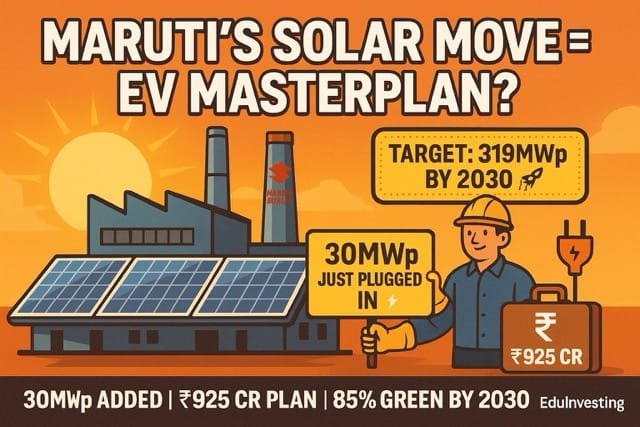🟢 At a Glance
Maruti Suzuki just added 30MWp of solar power across its new Kharkhoda and Manesar plants. The company plans to invest ₹925 crore to reach 319MWp solar capacity by FY2030–31, aiming to draw 85% of its electricity from renewables. So… while everyone’s chasing EV hype, Maruti is building its solar empire quietly. 😎
☀️ Solar Surge Highlights
| Facility | Capacity Added | Total Solar Capacity (2025) |
|---|---|---|
| Kharkhoda | 20MWp | New addition |
| Manesar | 10MWp | Expansion |
| Total MSIL | 30MWp | 79MWp (up from 49MWp) |
💰 Future Vision: ₹925 Cr Green Investment Plan
- 🚗 FY2030–31 Target: 319MWp solar power
- 🌞 Renewable Electricity Share: 85% of total consumption
- 📍 Alignment: Suzuki Global’s Environment Vision 2050 + India’s solar goals
Hisashi Takeuchi (MD & CEO): “We’re scaling up to 4 million units production, and we want the energy footprint to stay green.”
🔌 This Ain’t Just CSR — It’s Strategic
While Tata and Mahindra are betting big on EVs, Maruti is executing a long-term green power play. Why?
- ✅ Cheaper production via solar = long-term margin benefit
- ✅ Avoiding future carbon taxes or energy penalties
- ✅ Building ESG credentials (UN SDG #7 alignment)
- ✅ Future-proofing its new Kharkhoda mega-facility
🎯 EduInvesting Take
Forget the EV press conferences and flashy batteries — Maruti is becoming India’s Tesla… of industrial solar.
They’re not rushing into EVs because they know the real leverage is in cost-efficient production, not overpriced lithium.
📉 Stock Price Impact? Minimal (for now).
But institutional investors are watching. ESG funds might soon swipe right.
🤔 Risks & Watchpoints
- Cloudy ROI timelines: Solar ROI is slow and capital intensive.
- Policy dependency: Any rollback in government incentives could affect returns.
- No direct EV strategy yet: Investors still want clarity on EV roadmap.
Tags: Maruti Suzuki, Solar Expansion, Kharkhoda Plant, Manesar, Renewable Energy, ESG, EV Strategy, Indian Auto Sector, FY2030 Goals, EduInvesting
Author: Prashant Marathe
Date: June 4, 2025




















